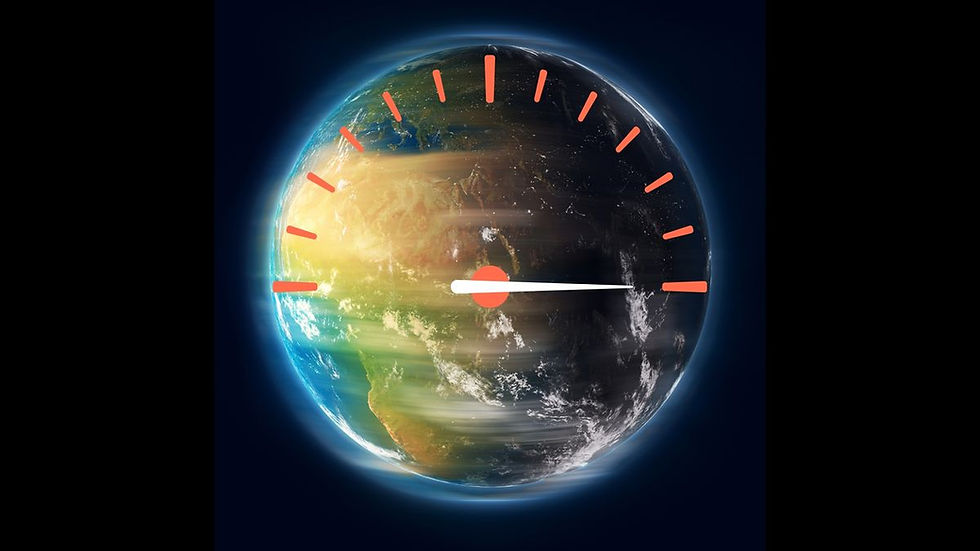Why the Earth Is Spinning Faster
- TPP

- Jul 25
- 4 min read

Earth has been spinning slightly faster in recent years, leading to a series of record-breaking “shortest days.” The most recent instance occurred on July 10, 2025, when the Earth completed a full rotation 1.36 milliseconds faster than the standard 24 hours. This made it the shortest day of the year so far. Just days later, on July 22, the Earth again spun faster than usual, completing its rotation 1.34 milliseconds early — marking the second-shortest day of 2025. These millisecond-scale changes might be imperceptible to humans, but they hold significant implications for timekeeping and Earth sciences.
To understand what’s happening, it’s important to understand the concept of Length of Day (LOD) — the time Earth takes to complete one rotation on its axis, normally measured as 24 hours or 86,400 seconds. However, Earth’s rotation is not perfectly uniform; it varies by fractions of a millisecond (1 millisecond = 0.001 seconds). These tiny shifts are measured using atomic clocks, which are ultra-precise timekeeping devices capable of detecting even minuscule changes in Earth’s spin.
Until 2020, the shortest day ever recorded was in 2005, when the Earth completed its rotation 1.05 milliseconds faster than usual. That record stood for years — until the Earth began unexpectedly speeding up. On July 5, 2024, Earth broke its own record by completing a rotation 1.66 milliseconds faster than 24 hours, becoming the shortest day ever recorded.
What Affects Earth's Rotation Speed?
The reasons behind these speed changes are complex and multi-layered. Several factors contribute to variations in LOD:
Gravitational influence of the Moon: The Moon exerts a tidal pull on Earth, which typically acts as a brake, gradually slowing Earth’s rotation over geological timescales. Interestingly, the Moon’s position relative to Earth's equator can also slightly alter rotation speed. When it is closer to the equator, Earth tends to spin slower; when farther, it spins slightly faster.
Seasonal changes in the atmosphere and oceans: The interaction between Earth’s atmosphere, oceans, and rotation means that seasonal weather patterns can redistribute mass and alter angular momentum. According to the conservation of angular momentum (a physics principle that says the total spin of a system must remain constant unless acted on by an outside force), if the atmosphere slows down, Earth must spin slightly faster to compensate.
Earth’s liquid core: Perhaps the most compelling theory relates to the inner dynamics of Earth itself. Recent studies suggest that the slowing of Earth’s liquid outer core — the molten layer beneath the mantle — may be causing the solid Earth (crust and mantle) to rotate slightly faster. This shift in mass and motion, deep within the planet, could be contributing significantly to the recent speeding up.
Melting ice and sea level rise: Another 2024 study proposed that the redistribution of Earth’s mass due to melting polar ice caps and rising sea levels could be impacting Earth's spin. However, this is likely a moderating factor, not the primary cause.
Despite these possible explanations, scientists acknowledge that the root cause remains elusive. According to Leonid Zotov, an Earth rotation expert at Moscow State University, "most scientists believe it is something inside the Earth," adding that oceanic and atmospheric models alone do not fully explain the current acceleration.
Leap Seconds and Timekeeping Risks
Why does this matter? Because the precision of Earth's rotation underpins global timekeeping systems, including GPS, telecommunications, and financial networks. For decades, Earth’s gradual slowing led scientists to occasionally add a “positive leap second” to Coordinated Universal Time (UTC) — an adjustment made 27 times since 1972 to ensure atomic time remains in sync with Earth time.
Now, with Earth spinning faster, scientists may eventually need to introduce a “negative leap second” — subtracting a second from atomic time. This has never been done before and could disrupt critical systems, much like the feared Y2K problem at the turn of the millennium.
If the current trend continues, experts predict a negative leap second might be required around 2029. That’s why agencies like the Earth Rotation and Reference Systems Service (IERS) and the US Naval Observatory are closely tracking the data.
A Temporary Anomaly or New Normal?
Looking forward, scientists had anticipated that July 9, July 22, and August 5, 2025, would be the year’s shortest days. However, July 10 unexpectedly took the lead. While August 5 is still predicted to be about 1.25 milliseconds shorter than usual, it won’t beat July 10’s record.
Interestingly, there are signs that the acceleration might be tapering off. Zotov suggests that Earth’s spin may soon slow down again, aligning with its long-term trend of gradually lengthening days — a process driven by the Moon’s tidal friction, which has been pulling the Moon farther from Earth and slowing Earth’s rotation for billions of years.
In Earth’s early history, days were much shorter — about 19 hours long, due to a balance between solar atmospheric tides and lunar ocean tides. Over geological timescales, this balance has shifted, and days have steadily grown longer. So, this recent speeding up might just be a temporary anomaly in a much longer, more gradual deceleration.
Explore more on UPSC Content
Click for Daily Quotes:
Stay updated with the latest news by joining our Telegram channel – The PRESS Pad , and follow us on Instagram



Comments